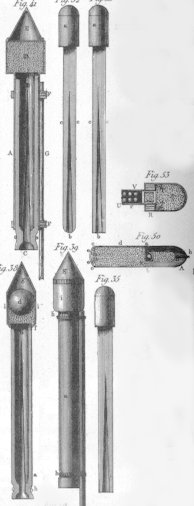India and Congreve
Today, let's talk about English rockets in the War of 1812. The University of Houston's College of Engineering presents this series about the machines that make our civilization run, and the people whose ingenuity created them.
"The rockets' red glare, the bombs bursting in air" -- words set to an old English drinking song. They tell about an attack of 32-pound English Congreve rockets on our Fort McHenry in 1814. They were a new weapon of war, with a range of about three miles.
Military rockets have had two brief periods of importance in the West: since WW-II, and 50 years of Congreve rockets.
The Chinese invented war rockets 1000 or so years ago. Rockets soon spread to Europe and India, but their only tactical importance was in India. India's landscape of small hills and stony river beds made it hard to move artillery around. India also had the best Asian supplies of saltpeter for making powder.
The 16th-century Mogul emperor Akbar used military rockets. By the 18th century, rocket troops were an important part of most Indian armies. They used 6 to 12-pound rockets with a range of a mile or so. Those troops savaged invading English cavalry.
William Congreve was a bright kid who grew up in the late 1700s amid English ordnance at Woolwich Arsenal and Indian rockets in the Royal Artillery Museum. His father, a veteran of the American Revolution, had founded, and now ran, the Arsenal.
Young William was wonderfully inventive. When he was 13, he proposed to travel to the moon in one of the new French balloons. By the age of 28 he published a whole folio of inventions. And it included far more practical stuff than ballooning to the moon.
But those Indian rockets are what captivated Congreve. In 1804 he realized that rockets exert no reactive force -- none of the "kick" of a cannon. That especially suited them to use at sea. He developed his own version of those Indian war rockets.
After failed tests against French shore installations, Congreve managed to burn most of the city of Copenhagen -- a hapless bystander in the Napoleonic Wars. From then on, English rockets played an important part in war against the French.
But, in the War of 1812, England turned the full fury of Congreve's rockets on us -- from Bangor, Maine, all the way to New Orleans. It was Congreve's rockets that burned Washington in 1814. Our most powerful image from that event is Dolley Madison reentering the burning White House to save its art treasures.
The English also tried to take Baltimore, but they failed when their rockets couldn't take out Fort McHenry, guarding the city. War rockets lasted another 40 years. They were finally replaced with heavy artillery as ships became ironclad. So they died out until the V-2 rockets and bazookas of a century later. And, today, we celebrate America with an unsingable English tune about those English rockets. I do find that hard to understand.
I'm John Lienhard, at the University of Houston, where we're interested in the way inventive minds work.
(Theme music)
Winter, F.H., The First Golden Age of Rocketry, Washington, D.C.: The Smithsonian Institution Press, 1990. (I am grateful to Jeffery Scoggins of Detering Book Gallery for directing me to this source.)
Von Braun, W., and Ordway, F.I., III, History of Rocketry & Space Travel, (revised ed.) New York: Thomas Y. Cromwell Co., 1969.

clipart
Typical Congreve-type rockets from the early to mid-19th century